Letter to a Friend in New York by Isabelle Graw
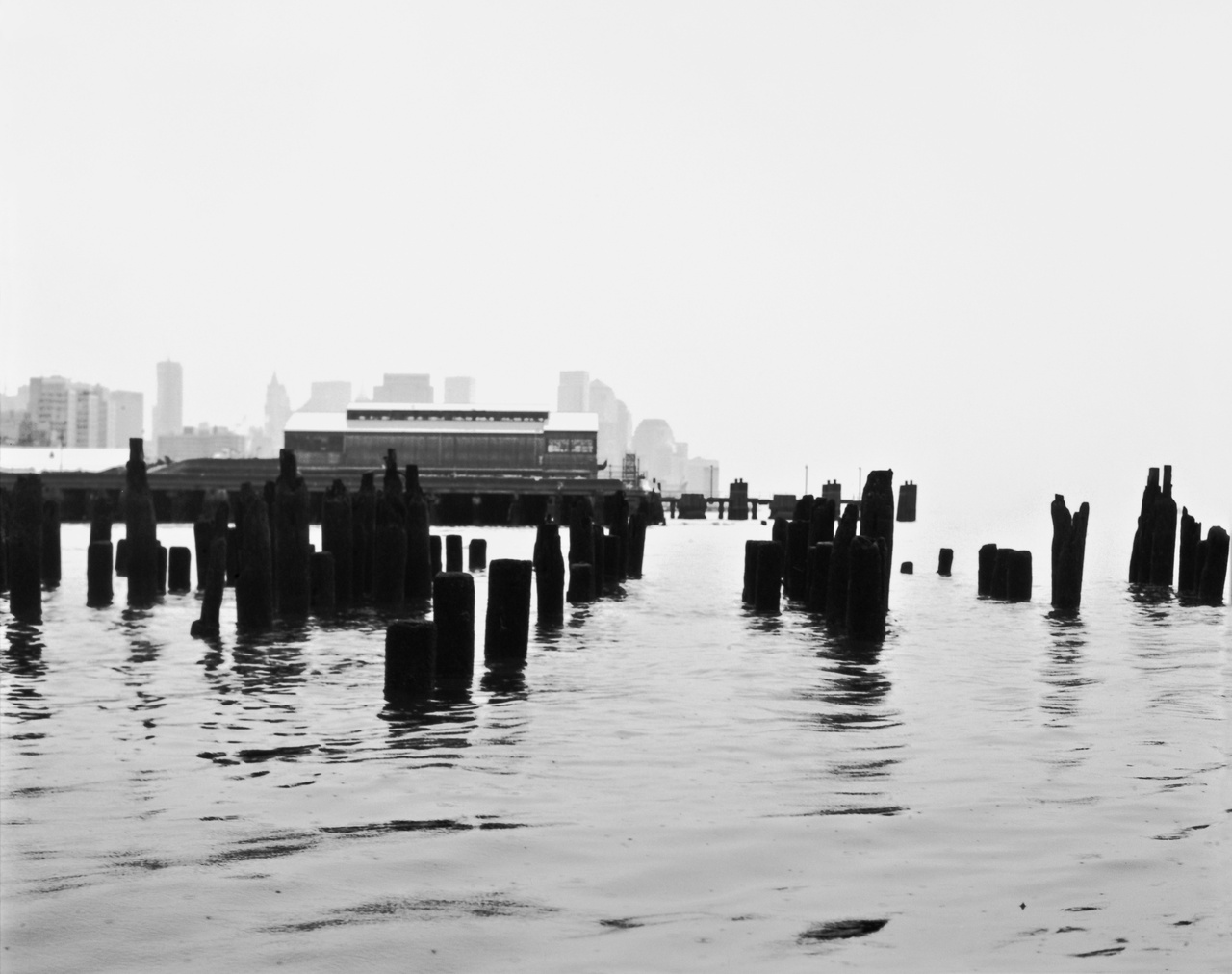
Emily Roysdon, „The Piers Untitled (#5)“, 2010
Literary figures from Virginia Woolf to Chris Kraus have availed themselves of the form of the letter to offer extended and searching meditations that interweave the personal with current affairs, communicating their thoughts on politics to a public readership in the intimate tone of a conversation with a friend. In the following letter, Isabelle Graw shares her reflections on the impact of the Trump regime and neoliberal policies on the art world.
Following a recent trip to the US, Graw discusses the prevailing mood in the New York art world, suggesting important parallels between the developments in the US and her home country, Germany. Through correspondence, the discussion about the current state of affairs begins, ever so slightly, to open itself to further analysis.
Berlin, July 11, 2018
Dear Marianne,
I got back home safe and sound and am sitting down right away to write you a long letter. Unfortunately, I had very little time in New York during this trip and so we didn’t get around to discussing things at length, which I regret very much. So I wanted to share my impressions of New York with you in writing. The following reflections may be a little gloomier than they would be if I weren’t feeling rather fragile at the moment; you know why. I just read something in Hannah Arendt’s letters to one of her female friends that describes my situation well: she feared that her bad mood during a trip to Israel had tarnished all her impressions of the country. But perhaps such correspondence between the private and the political may also be read as evidence that both are connected by an inherently flexible interrelation?
I’ve often told you that New York has long been my place of yearning. But this visit was different – I experienced the city instead as a dismal vision of the future, a premonition of what may come to Berlin as well. Here, too, people are now scared of losing their apartments or facing exorbitant rent increases, and that fear makes for a pervasively tense mood that I notice increasingly in everyday life. For example, I’ve lately heard from numerous artists from our mutual circle of friends that the leases on their studios have been terminated or that they’ve received notice of a rent hike they can’t afford. Luckily, this trend has provoked protests, most recently from the tenants of the Kunst- und Gewerbehöfe on Muskauer Straße. Still, I fear that artists and the entire creative class, except for the lucky few top earners, will in the long run find themselves displaced out of the center. In New York, their exodus from Manhattan is long complete.
In the past several years, New York has become an illustration of what happens when no effort is made to curb a highly speculative investment culture. During this visit, the luxury apartment high-rises springing up everywhere seemed to me emblems of the fact that a dodgy real-estate guy rules the country. In Midtown in particular, the construction activity struck me as positively frenzied. The glass towers going up sport the same depressing corporate aesthetic I’ve seen in cities like Dubai and downtown Vancouver. The majority of the apartments in these skyscrapers sit empty most of the time, and so the urban scene around them is virtually dead. It says something that, as people in New York told me, more and more small retailers such as dry cleaners and grocery stores go out of business simply because their client base has vanished. I wonder if you see signs that the same trend is coming to your neighborhood.
Here in Berlin, the city government is hesitantly taking measures to prevent a similar shift from organic neighborhood cultures to the dead city of investors’ dreams, for example by extending “milieu protection” to larger areas, a legal instrument that would be unthinkable in the US. Still, when I consider the effects of gentrification even merely along my own street in Berlin – numerous artists have moved away, and businesses from the kiosk and the flower shop to my favorite café have closed to make room for fashion boutiques – I fear that tomorrow’s young artists will tend to stay away from Berlin simply because they won’t be able to afford to live here.
Perhaps it was because I was more sensitive than usual, but this time around it seemed to me that the noise in New York – it’s always been a noisy city – was even worse due to the construction everywhere. Do you experience the thunderous racket of passing trucks and the ear-splitting ambulance sirens as a kind of constant physical assault that makes every fiber of your body ring? I do. Is that something that happens as we get older? Or is it a kind of displaced bodily response to the threat posed by the Trump administration?
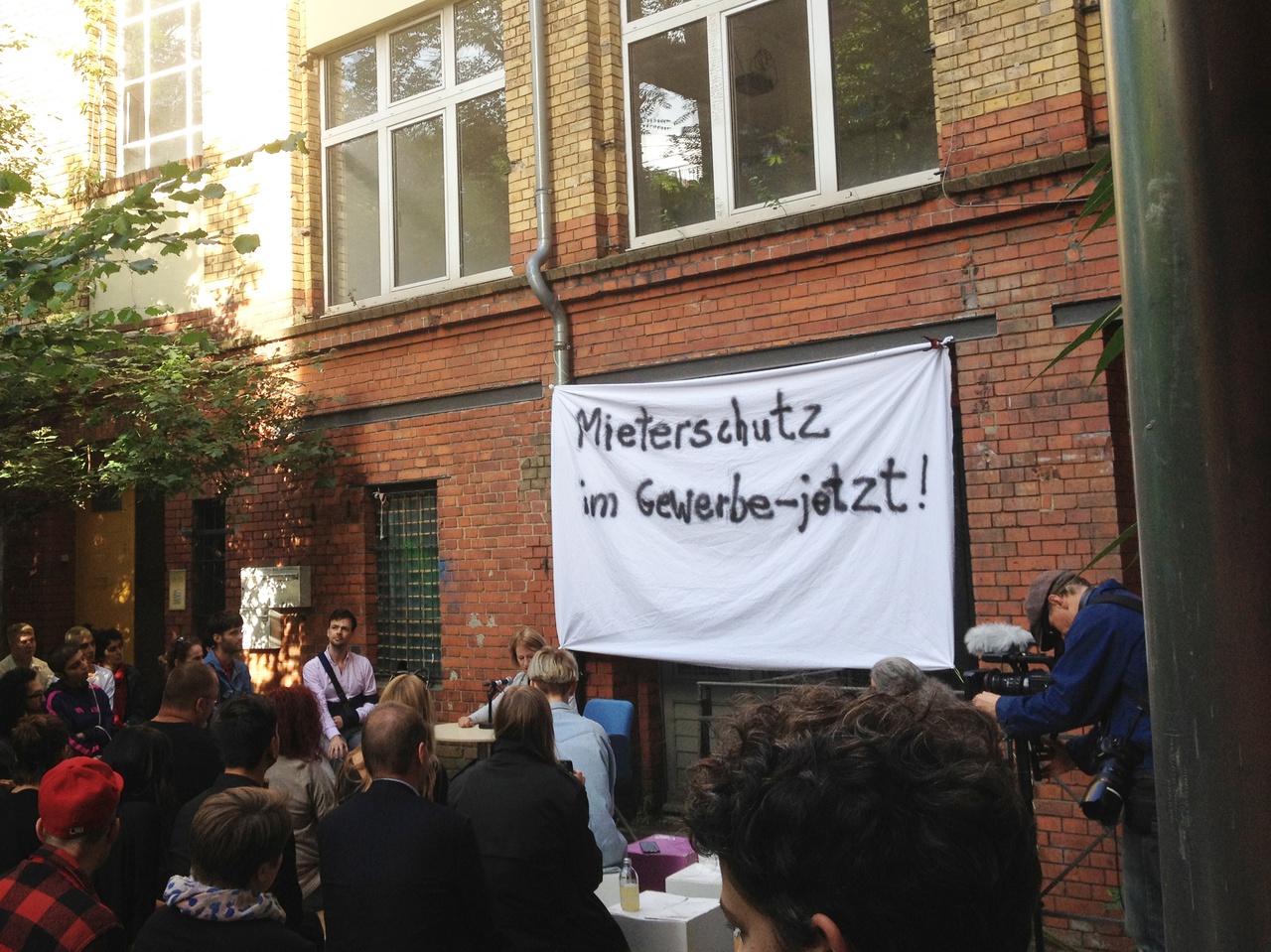
Proteste des Atelier- und Gewerbehofs / protests in front of the Artist Complex at Muskauer Straße, Berlin, 2018
By the way, it feels to me like the number of ambulance cars racing down the streets has gone up in Berlin as well in recent years. You get the sense that significantly more people are in dire straits. With the many emergency vehicles – on Torstraße, one comes through virtually every minute – my life in Berlin now feels like I’m on constant alert, and that goes hand in hand with my dismay over the swing to the political right in Germany as elsewhere and the rapidly rising tide of xenophobia.
It’s primarily migrants and nonwhites who are being threatened, not privileged citizens like you and me. One is almost ashamed of one’s German passport with all the unearned entitlements that come with it, like a level of mobility that people in the countries targeted by the travel ban can only dream of. Left-wing media have drawn attention to the ways in which the Trump administration is pushing ahead with the transformation of a democratic system into an autocracy with plutocratic features. Most recently, the nomination of a second Trump-friendly judge to the Supreme Court has added to the fears of such a frightening scenario. The media have also pointed out that both the administration’s rhetoric – the lies, racist discrimination, and dehumanization of migrants – and its methods – distracting from the core issue by abruptly changing the subject, blindsiding the opposition, the use of advanced means of communication (Twitter), and systematic attacks on the free press – are reminiscent of the early phases of cruel dictatorships in the past. Knowing these things, I’ve watched Trump’s erratic press conferences in horror – he comes across as an autocrat with a narcissistic personality disorder, admonishing journalists to be nice to him.
But on the subject of Trump, what really struck me in New York was that the kinds of artists and gallery people I’m friends with hardly mention his name anymore. Is that your impression as well? It seems as though the reality of life under Trump is repressed, as if it had no effect on artistic production, which is a fallacy. Perhaps it’s a way to keep a last spark of optimism alive? The almost aggressive entanglement with micro-politics can be observed everywhere in New York, another form of willful blindness to the reality of Trump. But this new reality of a quasi-fascist America obviously does affect artistic production; more specifically, it affects the consciousness of the creative class. I met friends in New York who seemed to be in shock and at the same time obsessively devoted to their jobs, fixated on their spot in the larger system and busy trying to secure their creative (and, needless to say, economic) survival. There’s obviously something to the blanket reproach against the leftist-liberal milieu, that it’s primarily concerned with defending its privileges and that its active commitments don’t go beyond symbolic gestures. But given the enormous financial pressures and fierce competition most people in the art world face, they often have their hands full keeping their own lives and careers on track, and for many it’s all they can do. In crises like these, it turns out that few artists and theorists have the energy to become actively involved, assisting refugees, for example, or standing up to the racism that creeps into the mainstream political discourse.
On the other hand, I can relate: in the long run, obsessing over Trump and his ideology of white supremacy is just too depressing – it makes you constantly aware of your impotence and forces you to admit that the cultural Left as a whole is rather powerless right now.
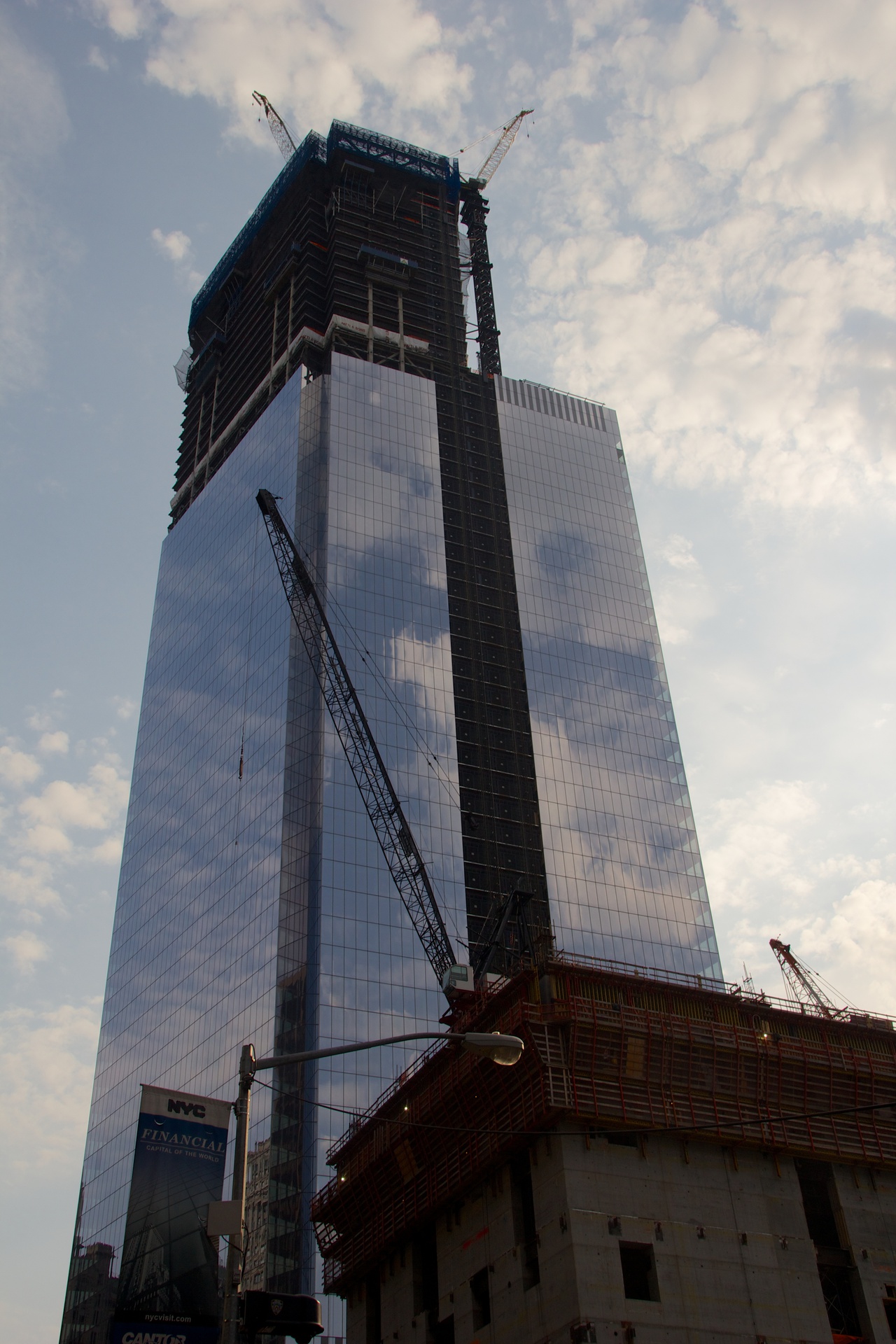
Bau des / Construction of „Four World Trade Center“, New York, 2012
You’ll perhaps object that the New York art world has in fact mounted a vigorous response, especially to the Trump administration’s racist policies, supporting the most important protest against Trump in the struggle against racism in the form of a redoubling of efforts toward diversity, showing more work by nonwhite artists in galleries and museums. I agree, as far as that goes: putting together a group show exclusively with white Western artists has become virtually unthinkable, and that’s an important achievement of the current debates over postcolonialism and globality – progress that, I hope, won’t be followed (as it often is) by a backslide. What I find difficult, however, is that the legitimate critique of white privilege and the exclusion of black artists is often articulated in neo-essentialist terms, as though “black” and “white” were the essences of identities, when the debates over identity politics of the 1990s have taught us to see these identities as self-contradictory and multidimensional: plural identities was the key phrase. At the same time, it’s difficult to derive concrete political demands from plural identities. That’s why the “strategic essentialism” some already advocated in the 1990s seems to be making a comeback, though one oddly uninformed by the discussions back then, which have of course since been further developed.
Moving on: What do you think is the reason why the art world (in New York as much as in Berlin) seems to muster little opposition to Trump’s policies (or to the AfD and Seehofer’s xenophobic closed-door policy) beyond donation drives, petitions, conferences, and the occasional protest? I often think that this reticence has something to do with the widely held belief that being involved in art almost automatically puts one on the “right” side, as though one would naturally belong to the emancipatory, anti-racist, or anti-capitalist struggles. What’s more, art is often credited with the capacity to transcend existing realities, to soar above concrete social conditions. Did you see the telling quote by Gerhard Richter from 1982, which he wrote down again for Hans-Ulrich Obrist following their recent interview? Obrist then posted Richter’s quote on his Instagram account: “Art is the highest form of hope.” Here art is declared the bearer of hope par excellence, although in 1982 the reasons for hopelessness were likely different than today’s. What may apply to Richter personally, then as now, is that his art gives him hope. But so expressed, this very personal truth threatens to mystify artistic production as a whole, turning art into a lofty universal principle that, in reality, is no less a “problem nexus” (Adorno).
Given that, as Ernst Bloch already noted in “The Principle of Hope,” hopelessness is unbearable and unlivable, I can understand why artists would invest all their hopes in their art. But such a flight from reality also hides art’s social references, such as its involvement in the sphere of money and power. You know I’ve always conceived of the idea of “art” as an intrinsically evaluative concept and studied the diverse types of value into which works of art break down. This value dimension of art (and hence its ability to generate hope!) is what makes it so appealing to wealthy oligarchs and collectors with conservative political leanings. Since the early modern era, the art sphere has been associated in various ways with conservative milieus that underwrite it. I think one needs to reckon with this association and the fundamental compromises it requires from art in arguing that it can be a source of hope.
Andrea Fraser’s new book, which I highly recommend to you, shines a spotlight on the Trump supporters who currently sit on the boards of trustees of various museums. That strikes me as a step in the right direction, especially since Fraser makes no effort to hide her own connections to these circles, explicitly noting the shows she’s had at museums with Trump supporters in leadership roles. As Fraser points out, a sizable share of museum trustees and collectors (32%) donated to Trump’s election campaign. But almost no one I talked to in New York mentioned this intersection between the art world and Trumpland, except to observe that the money that Trump’s tax cut puts in the pockets of the wealthy is flowing directly into the upper segment of the art market, fueling an ongoing boom. No one seems to think that this close bond between the pro-Trump camp and parts of the art world calls for some kind of action. You don’t bite the hand that feeds you.
Still, it’s not just the galleries that sell to Trump supporters that have a problem. I think all of us who produce “meaning” in the form of contributions to the discourse or art help ensure a steady supply of credibility. I’ll go even further and say that, in the age of Trump, the potential for resistance implicit in the bohemian-transgressive lifestyle that many artists between New York and Berlin still cultivate has been thoroughly depleted. That’s because the new resident of the White House is a type whose behavior strikes me as only all too familiar. The comparison may be a bit far-fetched, but in my opinion Trump’s penchant for rule-breaking, slack of transparency, lying, and sexism is something we’ve seen before: in many prominent – male, heterosexual – protagonists of the 1980s and 1990s art world, whose informal organization encouraged these tendencies. What may have felt like interesting nonconformism in a bohemian milieu that prized artistic self-expression (though needless to say it was intolerable, especially for women) becomes utterly unacceptable when it’s modeled by the American president. Under the #MeToo banner and in other ways, women have rightly protested the entrenched sexism in the art world; forms of behavior we had to put up with in the 1980s are now considered beyond the pale and can be rebuked and sanctioned promptly.
Do you share my sense of a mounting backlash from all sorts of places against this heightened sensitivity to sexism? At the FAZ’s culture desk, for example, the old boys are closing ranks and gushing over the George Circle, and a recent article on the section’s front page argued that gender-inclusive language violated German grammar. Yes, grammatically speaking, generic nouns are inclusive of women, but what does that mean in political terms, and which exclusions does it imply? It was symptomatic that this commentator simply ignored the political dimension of generic language.
Meanwhile, the art milieu’s appeal seems to have faded considerably in recent years; many of our friends working in other segments of the cultural field have turned their backs on it. Have you noticed that as well? I see two reasons why the art world’s luster has dimmed. One, as I’ve mentioned, in the age of Trump, the bohemian lifestyles the art world embraces appear in a new (and dubious) light; and two, with its free-thinking spirit gobbled up by the neoliberalism of corporate galleries and big art fairs, a part of the art world has turned into a conservative VIP lounge that many people find unattractive. The upshot is a crisis of credibility affecting not only the milieu itself but also the products circulating in it.
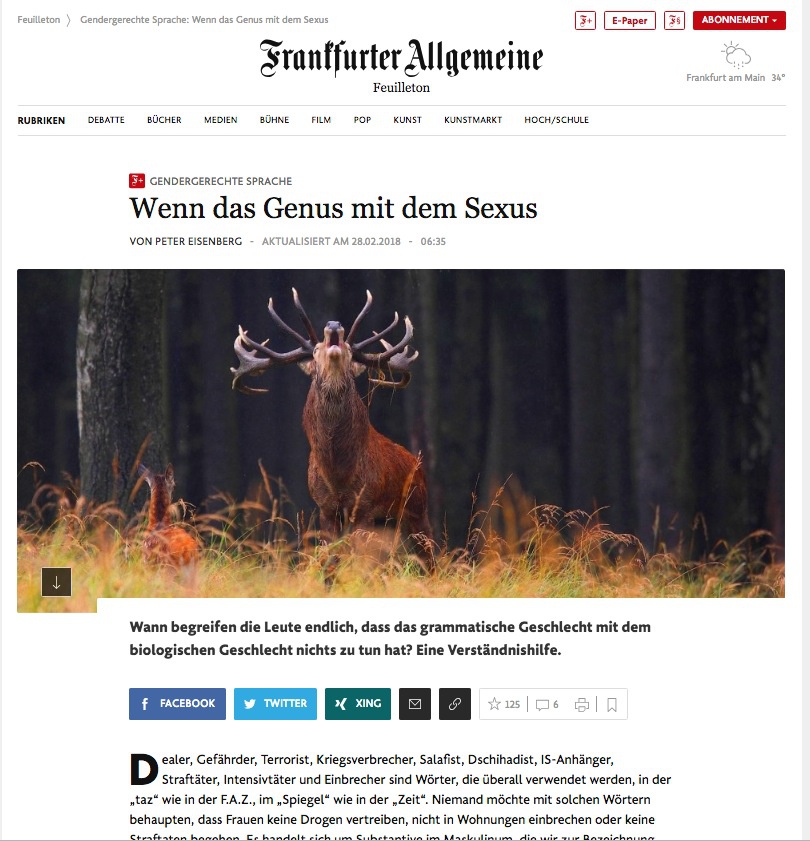
Peter Eisenberg, Wenn das Genus mit dem Sexus, F.A.Z. vom 28.02.2018, Screenshot
In light of these developments, I wanted to ask you: Have you followed what’s been happening at Artforum ? In his first interview, the new editor-in-chief, David Velasco, casts himself as a “bohemian” buoyed by a boundless romantic belief in “incredible art,” for which he would give, I quote, his “life.” The histrionic willingness to die for art makes it something that is worthy of the ultimate sacrifice: a value that is beyond all doubt. He gives no hint of any awareness of the entanglements between art and Trumpland and downplays his own magazine’s #MeToo scandal with the observation that Knight Landesman isn’t Artforum . In the interview, which is memorable also for not mentioning the work of his predecessor, Michelle Kuo, with a single word, Velasco moreover reveals his preference for lifestyle writers like Rhonda Lieberman and admits that he doesn’t find art-historical “expertise” particularly relevant or interesting. At the current juncture, such a dismissive view of the kind of specialized knowledge that lets us understand art in its social contexts strikes me as a huge mistake. To make matters worse, this move away from expert knowledge bears structural similarities to Trump’s attitude. As we learned from “Fire and Fury,” the president has nothing but contempt for the science of climate change and has systematically eliminated experts from the upper echelons of government.
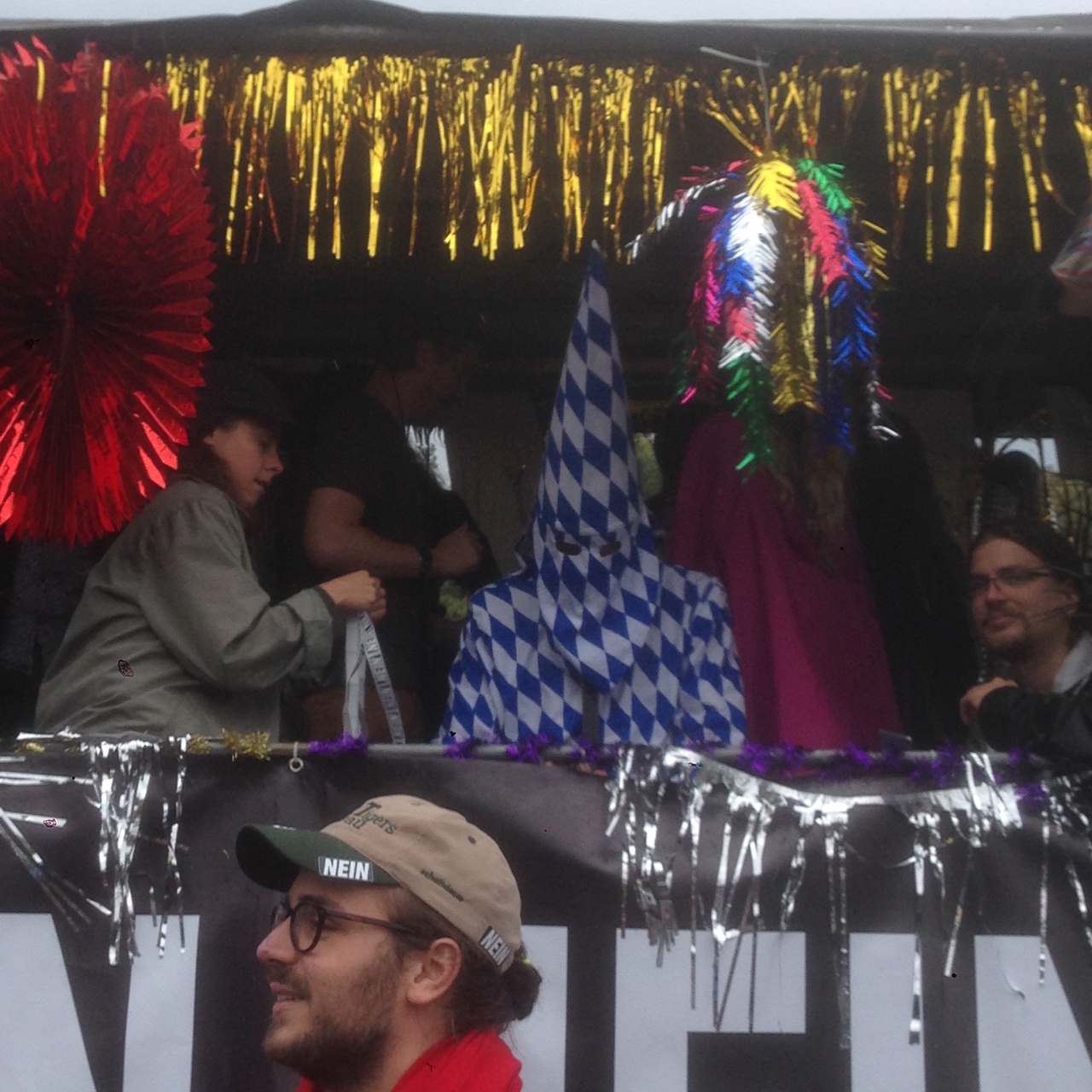
Großdemonstration „#ausgehetzt“ / Mass demonstration „#ausgehetzt“, München / Munich, 2018
I’d known about the personal, financial, and ideological intersections between the Trump camp and the art world before I came to New York. But what I hadn’t fully grasped until I got there was the devastation wrought by the Trump era not only on urban life but also on the thinking and behavior of New York’s cultural producers. It brings Bloch’s portrayal of what happened in the 1930s to mind (I’m not usually a fan of his portentous style, but this passage captures well what we’re seeing today): “Many only feel confused. The ground shakes, they do not know why and with what. Theirs is a state of anxiety …” This anxiety – Bloch also called it “fear of life” – is palpable beneath the surface of the New York art world. But rather than invoking, like Bloch (and Richter, via Obrist), the “principle of hope” (sustained by art), I think we need a more exacting analysis of the overlap between Trumpland and the art world. As painful personal experience has taught me, anxiety is never a good guide in life. Perhaps the time really has come – also in light of the Europe-wide failure of a left-wing politics that people like Didier Eribon have rightly held responsible for the dismantlement of labor rights and social safety nets between 1998 and 2005 – for us to become more actively involved in politics. I know that many of our mutual artist friends have been toying with the idea of going into politics since Trump’s inauguration and the most recent federal election in Germany (in which the AfD won seats in parliament). But there’s been little real action and much of the initial energy has dissipated. So here’s my question to you: Shouldn’t we come together at long last to do something about this horrifying situation?
Love, Isabelle
PS. I shared a draft of this letter with Sabeth and Beate; some of the above reflects their very helpful comments. Both send their love!
Translation: Gerrit Jackson
